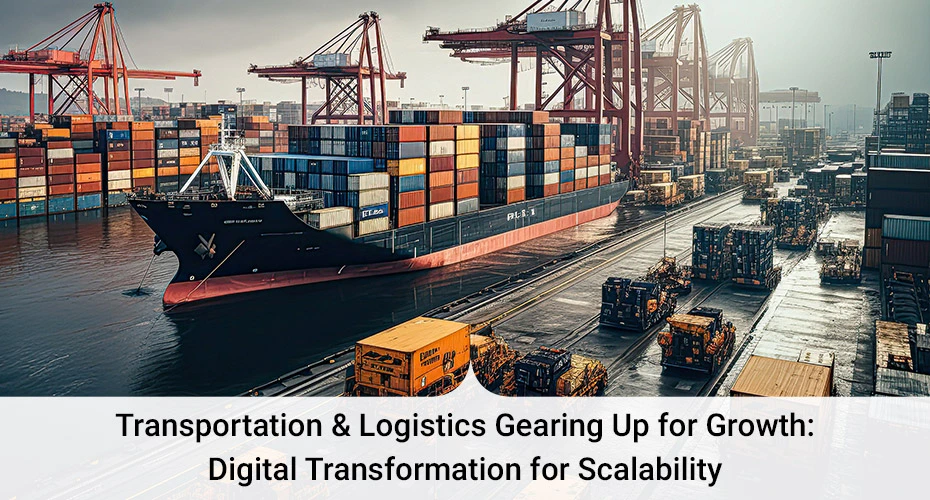The transportation and logistics landscape has undergone a tectonic shift in the last couple of years. As economic and socio-political headwinds emerge, the focus isn’t just on increasing efficiency and ensuring just-in-time deliveries. There is an urgent and widespread need to embrace modern technology to boost supply chain resiliency while enhancing agility to address unforeseen disruptions. There is also an increasing focus on worker safety and environmental sustainability, making it difficult for companies to grow and scale their businesses.

This three-part blog series explores the multifaceted approach necessary for the transportation and logistics industry to thrive in the digital era, leveraging technology to drive growth, elevate customer service, and tailor solutions to complex operational landscapes. The first part examines how embracing digital transformation paves the way for scalability and growth within the transportation and logistics sector.
Top Transportation and Logistics Challenges
In today’s disruptive era, transportation and logistics businesses face a variety of challenges:
- Supply Chain Disruptions: Geopolitical conflicts, economic uncertainty, and ensuing wars impact the quality and efficiency of global supply chains in many ways. These can lead to delays in shipments, shortages of goods, and increased operational overheads.
- Rising Costs: Surging fuel prices, labor costs, and regulatory compliance expenses put immense pressure on the profit margins of transportation and logistics companies. Striking the fine balance between cost and quality is a constant challenge.
- Fluctuating Demand: The volatile business environment leads to several fluctuations in demand. In addition, seasonal peaks, and fluctuating load-to-capacity ratios tend to create numerous bottlenecks in the supply chain.
- Widening Skills Gap: Like most other industries, the transportation and logistics industry faces several hurdles in finding and retaining skilled workers.
- Siloed Systems: Transportation companies also struggle with operating a multitude of systems for order management, warehouse management, freight management, customer management, supplier management, capacity procurement, tracking and visibility, communication management, etc. Poor integration between these systems impacts data sharing while limiting visibility into the supply chain.
- Surging Customer Expectations: Today’s customers demand greater visibility, transparency, and flexibility in their shipments and prefer to engage with companies that work towards minimizing follow-ups on visibility and operational overhead. Meeting these expectations while balancing costs and quality levels is challenging for most logistics providers.
- Emerging Cybersecurity Risks: As technology continues to be integrated across global supply chains, organizations are becoming increasingly susceptible to cyberattacks. From data breaches to ransomware attacks, logistics and transportation companies need to have stronger mechanisms in place to protect sensitive information and make their systems cyber-resilient.
How Digital Transformation Solves Them
Addressing emerging transportation and logistics challenges demands an amalgamation of strategic planning, investment in modern technology and infrastructure, and a focus on innovation and agility.
a. Supply Chain Disruptions
- Real-Time Visibility: Implement IoT and advanced tracking systems to monitor the location and condition of goods in real-time, allowing for proactive management of disruptions.
- Predictive Analytics: Use big data analytics to predict potential disruptions such as weather events or port congestion, allowing for preemptive rerouting or rescheduling.
b. Rising Costs
- Automation: Deploy automation technologies such as robotic process automation (RPA) to handle repetitive tasks, reducing labor costs and improving efficiency.
- Optimized Routing: Use AI and machine learning algorithms to determine the most cost-effective routes for transportation, reducing fuel consumption and operational costs.
c. Fluctuating Demand
- Demand Forecasting: Leverage big data and machine learning to analyze market trends and historical data for accurate demand forecasting, enabling better inventory and resource management.
- Flexible Supply Chain Models: Implement digital twins and simulation tools to create flexible supply chain models that can quickly adapt to changing demand patterns.
d. Widening Skills Gap
- Training and Development: Use digital platforms for e-learning and virtual training programs to upskill existing employees and reduce the skills gap.
- AI and Automation: Implement AI-driven tools to handle complex tasks that require high skill levels, thus reducing the dependency on highly skilled labor.
e. Siloed Systems
- Application Programming Interfaces (API) Integration: Utilize APIs to connect Transportation Management Systems (TMS), Warehouse Management Systems (WMS), and other critical systems, enabling real-time data sharing and improved operational cohesion, ensuring smooth data exchange and interoperability.
- Unified Data Analytics: Deploy unified data analytics platforms that aggregate data from various sources, providing a comprehensive view of the supply chain and enabling informed decision-making.
f. Surging Customer Expectations
- Real-Time Tracking: Provide customers with live updates on shipment status through mobile apps and web portals, enhancing transparency and trust.
- Personalization: Use AI to offer personalized delivery options, such as choosing preferred delivery windows and locations, improving customer convenience and satisfaction.
g. Emerging Cybersecurity Risks
- Advanced Security Measures: Deploy advanced cybersecurity protocols, including end-to-end encryption and blockchain technology, to secure transactions and data exchanges across the supply chain.
- Employee Training: Conduct regular cybersecurity training programs to raise awareness and reduce the risk of human error-related breaches.
Increase Operational Efficiency
As businesses continue to operate globally, integrating different stakeholders across the order-to-cash shipment lifecycle and supply chain is crucial. However, the dependence on various systems to manage business operations across shipment booking, capacity procurement, customer engagement, carrier and capacity management, freight tracking, and accounting makes streamlining operations and enhancing agility a real challenge. Nonetheless, these challenges also allow businesses to embrace digital transformation and pave the way for scalability, growth, and long-term sustainability.
In the second part of the series, we explore how application modernization services can transform digital transformation initiatives within the transportation industry and can be a strong catalyst for change.
Looking to meet evolving internal user requirements and sustain market uncertainties? Learn how Synoptek can help drive innovation and create new opportunities for businesses to thrive in an increasingly interconnected and competitive global market.
About the Author
Parth Jani is a Principal Consultant with over 13 years of industry experience and brings a comprehensive skill set spanning technology and business domains. With a proven track record in presales, project execution, and product management, Parth transforms ideas into valuable solutions via business analysis and solution architecting. He has led numerous transportation and logistics projects, demonstrating deep sector knowledge. His strategic thinking and attention to operational details enable him to drive success throughout the business lifecycle while fostering team growth and collaborating closely with executives to enhance business performance.






